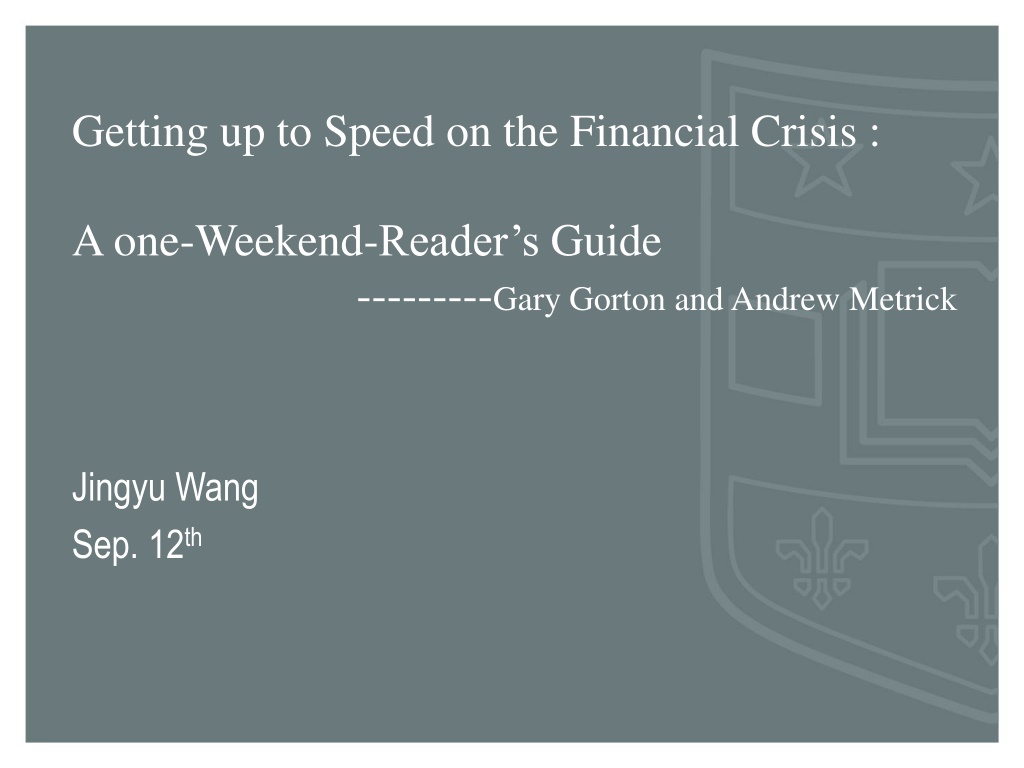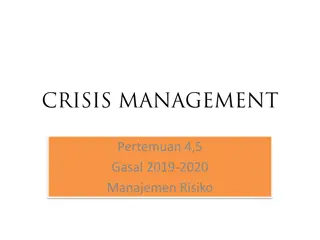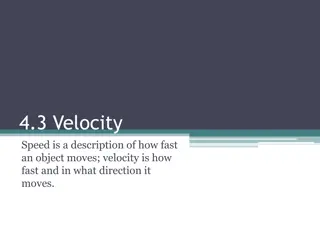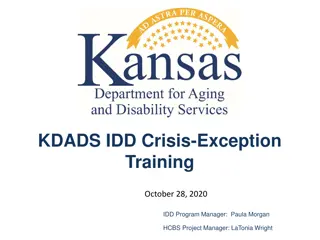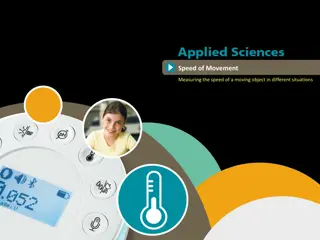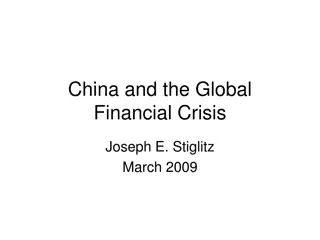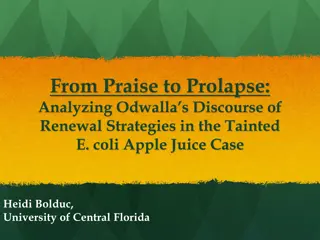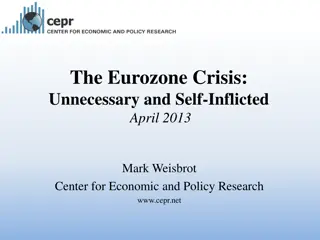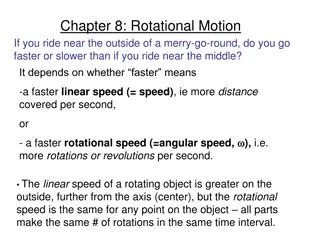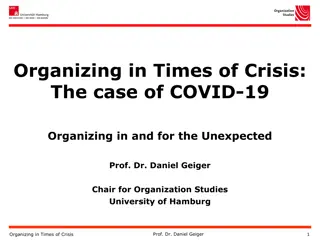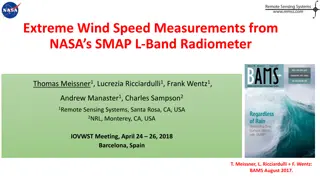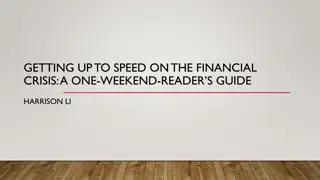Speed on Financial Crisis Document Highlights
"Reader's guide summarizes key documents on financial crisis build-up, panics, policy responses, and real effects. Covers historical perspective, crisis timeline, and recommended readings for quick understanding."
Download Presentation

Please find below an Image/Link to download the presentation.
The content on the website is provided AS IS for your information and personal use only. It may not be sold, licensed, or shared on other websites without obtaining consent from the author.If you encounter any issues during the download, it is possible that the publisher has removed the file from their server.
You are allowed to download the files provided on this website for personal or commercial use, subject to the condition that they are used lawfully. All files are the property of their respective owners.
The content on the website is provided AS IS for your information and personal use only. It may not be sold, licensed, or shared on other websites without obtaining consent from the author.
E N D
Presentation Transcript
Getting up to Speed on the Financial Crisis : Aone-Weekend-Reader s Guide ---------Gary Gorton andAndrew Metrick Jingyu Wang Sep. 12th
Objective speed on the literature of the crisis without having to go into a cave and read for a whole year. select and summarize sixteen documents, including academic papers and reports from regulatory and international agencies. Covers the key facts and mechanisms in the build up of risk, the panics in short-term debt markets, the policies reactions, and the real effects of the financial crisis.
Outline Section 2: Overview and Timeline of the Crisis 2010 testimony: Bernanke in front of the Financial Inquiry Crisis Commission Report Chapter from International Monetary Fund(IMF 2010) Bank for International Settlements(BIS 2009) Section 3: Historical perspective on financial crisis Reinhart and Rogoff(2011) Schularick and Taylor Accelerations in economy wide leverage and subsequent banking crises
Outline Section 4: The Crisis Build-up Pozar(2011): Institutional Cash Pools grew Bernanke(2005): sovereign-wealth grew Reinhart and Rogoff(2008): sharp increase in house price before crisis Case and Shiller(2003): housing bubble before crisis Section 5: The panics Covits, Liang, and Suarez: asset-backed commercial paper McCabe(2010): money-market mutual funds Gorton and Metrick: repurchase agreements and securitization Demand of short-term debt Provide a narrative of contagion where each step drains the banking system of hundreds of billions dollars and induces higher risk
Structure Section 6: Policy response IMF s Financial Stability Report (Oct, 2009): taxonomy and analyses policy actions across 13 countries from 2007-2009 Section 7: Real effects of the financial crisis Ivashina and Scharfstein (2010) : decrease in lending related to bank s reliance in short-term funding Puri, Rocholl, and Steffen(2011): shock to credit supply reduced consumer loan Campello, graham, and Havey (2010):credit constraints pulled back on investment Section 8: Conclusion
Section 2: Overview and Timeline of the Crisis Bernanke testimony(2010): Two vulnerabilities in financial sector: short-term debt(main): repurchase agreement and commercial paper shadowed bank :serve as intermediaries to channel savings into investment
Section 2: Overview and Timeline of the Crisis IMF Document: Details how repo market work Large but unregulated Total outstanding repo:Between 20 and 30 percent of US GDP in each year from 2002-2007 Disruption in US short-term debt creates shortage of US dollars
Section 2: Overview and Timeline of the Crisis Bank for International Settlements(BIS) Document Bankruptcy filling of Lehman Brother exacerbated whole situation Financial institutions facing the risk of default Run on money market mutual fund far more damage then subprime losses
Section 3: Historical Background understand the recent crisis from the phenomenon before the financial crisis Reinhart and Rogoff Results: external debt increases sharply, in advance of banking crisis banking crises tend to lead sovereign debt crises
Section 3: Historical Background Schularick and Taylor analyze financial crises with overall credit growth build a 140-year panel data set for 14 developed countries Results: changes in credit supply(bank loans) are a strong predictor of financial crisis, particular when these change are accelerate Provide a consistent picture :an acceleration of debt from both governments and financial intermediaries are the most important antecedents
Section 4: The Crisis Build-up Try to understand how the Crisis build- up Previous Section: Credit booms often precede crises Credit booms: asset-baked securities mortgage-backed securities Shadow banking system Securitization
Section 4: The Crisis Build-up Explosive growth in the six or seven year before the crisis, which consistent with credit boom
Section 4: The Crisis Build-up Pozsar(2011) Institutional Cash Pools and the Triffin Dilemma of the U.S banking System institutional cash pools: important Securitization growth of institutional cash pools have a associated demand for liquidity alternatives Not enough safe asset from US treasury for US to hold. institutional cash pools demand for insured deposit alternatives exceeded the outstanding amount of short- term government guaranteed instruments. demand for insured deposit
Section 4: The Crisis Build-up Bernanke(2005) The Global Savings Glut and the U.S CurrentAccount Deflict foreign official investors hold large amounts of US Treasuries institutional cash pool had to find substitutes 1) short-term bank debt-like products(repurchase agreements and asset- backed commercial paper) 2) indirect holdings of unsecured private money market instruments through money market mutual fund Asset-backed securities collateral credit boom houses) house price increase mortgage s preferred borrow money(buy Bubble?
Section 4: The Crisis Build-up Case and Shiller(2003) Is there a bubble in the housing market House price increasing is not a conclusive evidence of a bubble Bubble: a situation in which excessive public expectations of future price increases causes price to be temporarily elevated
Section 4: The Crisis Build-up House price run-ups prior to crises are common Reinhart and Rogoff(2008) Is the 2007 U.S Sub-Prime Financial Crisis so Different ?An international Historical Comparison.
Section 4: The Crisis Build-up run-up in housing prices in U.S.before crisis
Section 5: The Panics Two main panic period of the financial crisis : Aug. 2007, and Sep-Oct 2008. Three paper: Each focus on a different component of the short-term debt market major causes of financial crisis
Section 5: The Panics Covitz, Liang, and Suarez(forthcoming) Analyze runs on the asset-backed commercial paper market began in Aug. 2007 Commercial paper is important security for the financing of industrial firms minimize transaction cost Demand of CP is high increase use of long-term financial asset(Asset-baked commercial paper) Can bundle mortgages(securitization) transparent, lower funding cost, save on regulatory capital 1.2 trillion ABCP outstanding by July 2007
Section 5: The Panics Covitz, Liang, and Suarez(forthcoming) Meaning of a run on ABCP program : if lender(depositor) in bank are unwilling to refinance CP when it come to due. Mechanically, in any week a program does not issue any new paper despite having at least ten percent of its CP maturing Backup support from the program sponsor Force to sell asset
Section 5: The Panics Beginning in the week of Aug. 7th, the frequency of runs increased dramatically. By the end of 2007, 40% of program in a run, unable to finance themselves
Section 5: The Panics Covitz, Liang, and Suarez(forthcoming) Program more likely experience a run: high credit risk(exposure to subprime-related securities) high liquidity risk
Section 5: The Panics ABCP market fell a lot in 2007 significant impact on the balance sheet of those sponsor focus on money market mutual fund(MMFs), a major holder of ABCP McCabe(2010) Shirking ABCP downward pressure on asset classes held by many MMF
Section 5: The Panics Comprehensively analyses short-term debt market and the linking between ABCP and MMF s help to know how contagion in these market can spread. Did not figure out ABCP panic was drive by a weakness in subprime mortgage Repo markets play an important role in the contagion Gorton and Metrick(forthcoming)
Section 5: The Panics Gorton and Metrick(forthcoming) Repo is the shadow banking equivalent of a deposit market. When cash holdings far exceed insured deposit limits, large institutional money pools can lend short-term to a financial institution and receive collateral as protection For every $100 of collateral , an institution can receive $(100-x) in loans, with x% represent the haircut.
Section 5: The Panics Beginning of 2007, average haircut were near 0. First shock at the time of ABCP panic Steady rise each year Lehman failure,large drain
Section 5: The Panics Gorton and Metrick(forthcoming) subprime securities (small) Subprime failure(ABCP 40% market) unprecedented problems on MMF s(43 funds required support from their sponsors) 2007 Pressure on repo market interbank market near collapse intervention Financial Crisis Price drop, Initial panic onAug. Lehman collapse government
Section 6: Policy Response IMF Report Look short-term reaction of both economic stress index (ESI) and financial stress index (FSI) Interest rate cut: no short-run impact on the ESI, only limited evidence of a positive effect on the FSI Liquidity support was effect at calming interbank credit market in the early stages of the crisis, but not after the fall of Lehman Later stage, capital injection were the most effective policy
Section 7: Real Effect of the financial Crisis Crisis is global in nature Ivshina and Scharfsterin(2010) study the supply of credit during the crisis in order to understand the real effects of the panic on the corporate sector lending volume in the fourth quarter of 2008 was 47% lower than it was in the previous quarter, and 79% lower than at the peak of credit boom(2007:Q2) main conclusion: the decline in lending was in large part an effect of reduced bank loan supply
Section 7: Real Effect of the financial Crisis Puri, Rocholl, and Steffen(2011) focus on the issue of the supply of credit examine the effects of the U.S financial crisis on lending to retail customers in Germany Landesbanken(the regional banks , each in a province) suffer different extents due to their exposures to US subprime mortgages Overall decrease in demand for consumer loans, result of bank reduced the supply of credit
Section 7: Real Effect of the financial Crisis Effect of a reduced bank loan supply have on the real economy, on the activities of nonfinancial firms Campello, Graham, and Harvey(2010) 1,050 CFOs in thirty-nine countries in North America, Europe and Asia in Dec. 2008:whether they were financially constrained during the crisis.
Section 7: Real Effect of the financial Crisis 81% of the very affected firms reported that they experience less to credit, 20% has problems with lines credit Reduction in credit supply had significant impact on credit- constrained firm
Conclusion Financial crisis of 2007-09 was the most important economic event since the Great Depression. Similarity: the acceleration of system-wide leverage just before the crisis The crisis was exacerbated by panics in the banking system where various types of short-term debt suddenly became subject to runs. Novelty: location of runs, which took place mostly newly evolving shadow banking system, including money- market funds, commercial paper, securitized bonds, and repurchase agreements
My opinion CDS Short-term interest rate, government intervention
